Abstract | PDF | Volume 1 (Issue 2) | Request Permissions
Crossing No-Man’s Land: Wonder Woman & Liminality
Claire Meagher
Biography | Notes
Keywords: Liminality, Wonder Woman, Victor Turner, Superheroes, Patty Jenkins
Introduction
In Patty Jenkins’s 2017 film Wonder Woman, Diana—the titular character—transgresses social boundaries within modern myth and contemporary film. The film alters conventions by using Diana to explore her identity through liminality. The liminal figure invites analysis as they break the rules of society; they are outcasts, or characters that can slip between boundaries. In understanding what makes a figure “liminal,” one can better comprehend the definition of what it means to be an insider in society with an established status. In Wonder Woman, Diana enters various negotiations of power as she moves between spaces. In her quest to defeat Ares, the god of war, she faces pressures to conform to the WWI society around her but she does not easily fall into a defined category. The film takes the familiar tropes of superhero stories and alters the audiences’ expectations. This journey is marked visually through Diana’s treatment on camera as well as her costuming. As she leaves the Amazonian island of Themyscira to the ordinary world of humans, she moves from a position of sheltered naiveté (especially as it concerns the nature of war) to a realization of her own power. Her power becomes entwined with liminality which proves to be a source of her abilities.
Liminality
Liminality is a topic of study that speaks about the nature of insiders and outsiders to social groups, but it also lends itself to the nature of human experience and storytelling. Liminality is the experience or space that is felt when an individual cannot be defined by any one identity. By this definition, liminality becomes a “…fundamental human experience, [because] liminality transmits cultural practices, codes, rituals, and meanings in-between aggregate structures and uncertain outcomes.”[1] Since liminality is so all-encompassing, many people experience the phenomenon in their everyday lives. Bjørn Thomassen states that liminality may be present in an individual’s experience by outlining three different modalities: experiential (as felt by groups or individuals), spatial (physical areas of borders), and temporal (moments or years).[2] Each of these can be experienced by an individual or group throughout their lives.
Theories of liminality were initially developed by Arnold Van Gennep in what he called the “rites of passage” and refined by Victor Turner in the 1960s. In The Ritual Process, Turner applies Van Gennep’s three stages of liminality to consider how an individual is perceived as a “liminal entity” as they are initiated into a group or society.[3] Instances of this “rite of passage” may appear as graduation, coming of age ceremonies, or gaining citizenship. Turner expands on Van Gennep’s three phases of liminality: separation, threshold (the liminal period), and finally, aggregation.[4] At first, in the separation period, the subject is divided from their group or society, losing their previous identity or status in order to be integrated into the new group or society. During the next stage, it is difficult to be specific in describing this liminality, as Turner elaborates:
The attributes of liminality…are necessarily ambiguous since the condition and these elude or slip through the network of classifications that normally locates states and positions in cultural space. Liminal entities are neither here nor there; they are betwixt and between positions assigned and arrayed by law, custom, conventions, and [ceremony]).[5]
As Turner says, it is difficult to pin down the identity of a liminal entity, as they are defined as not having a stable identity as they are in a state of transformation, a state of flux. The liminal entity may or may not be accepted into society once again, embracing liminal status or finding their place in society.
The Amazons and Themyscira
To understand Diana’s liminality in the film, it is important to understand her origins with the mythic Amazons. She begins her journey on the legendary Mediterranean-esque island of Themyscira where she is raised by the matriarchal Amazons—the all-women warriors led by their queen Hippolyta. In the ancient Greek art, the Amazons, like those of Homeric literature, were frequently depicted as “violent, promiscuous, and war-loving…[which] became an analogous female challenge to the order of civilization.”[6] In short, these representations of Amazons were not obedient women so they posed as a danger to the Grecian patriarchy. The ancient Greeks frequently portrayed their mythic heroes (such as Heracles or Theseus) in conflict with the warrior women. The Amazons represented the antithesis of ancient Greek culture as they appeared “untamed, virginal, and aggressive, [and] they could serve to represent a phase of life for both young men and women: the androgynous state of life between childhood and adulthood. Yet Amazons serve as important paradigms precisely because they generally fail to make the transition to “maturity.”[7] This sentiment is, of course, important to the Wonder Woman myth; Diana, too, is represented in this capacity. She is also the exception to this interpretation of the Amazons—she leaves the island and gains a sense of maturity as she travels through the mortal world. The lack of maturity, however, also points to her liminality. The Amazons do not classify as any one thing according to Fantham, as she describes the warriors as both androgynous and between childhood and adulthood; the Amazons may appear as liminal figures as they break patriarchal conventions.
While their early depictions in the ancient world were less than sympathetic, the Amazons offered an alternative narrative to values that were held by Greek culture, especially concerning the show of masculine strength. Jill Lepore writes that by the twentieth century the figure of the Amazon was embraced by the early suffragettes as the term became synonymous with the rebellious “New Woman.”[8] The mythic warrior women served as a valuable metaphor for the suffragettes as the Amazons, too, rebelled against the patriarchy. For them, the Amazons were a symbol of empowerment—independent women who did not need to rely on men in order to survive and who themselves were empowered and strong. The overall impression then of these mythic beings was more positive for women of the early twentieth century. By the time that William Moulton Marston created Wonder Woman in 1941, the Amazons carried more positive connotations. Comic book scholar Andrew Deman argues that “Marston’s incorporation of Amazon mythology associates Wonder Woman with connotations such as strength, independence, sorority, and disregard for male-orientated societies.”[9] This idea, of course, is a central sentiment to Wonder Woman’s cause and this idea of strength is carried into the mythology of the 2017 film.
In this cinematic iteration of the Wonder Woman myth, the Amazons are created by the Greek gods to protect humans from the god of war, Ares, who is bent on destroying humanity. More importantly, like the Amazons of myth, Jenkins’s Amazons also offer an alternative to the masculine narrative of war—her Amazons not only protect but, as Hippolyta says to Diana in the film—they also “influence men’s hearts with love and restore peace to the Earth.”[10] Not only are they warriors, capable of protecting others, they also are a positive force for humanity. However, after Ares makes war on the gods themselves, the Amazons are forced to seclude themselves on the island of Themyscira in order to survive. To protect Diana and themselves, the Amazons create a barrier between themselves and the ordinary human world; Themyscira is then isolated in a form of stasis, as are its inhabitants.
The first part of the film shows Diana’s adolescence on the island of Themyscira and establishes the start of her journey as a liminal figure. This phase of Diana’s character represents a starting point in Turner’s theory of liminality. Turner describes, “The first phase (of separation) comprises symbolic behaviour signifying the detachment of the individual or group either from the earlier fixed point in the social structure, from a set of cultural conditions.”[11] Diana’s character is constructed in accordance to the Amazons on Themyscira but she is not yet integrated into the social group as a full member, so instead she holds a liminal position. Diana, as the only child of the island, is not yet a fully-fledged Amazon. At first, she is inspired to become a warrior like all of the women on the island but her mother, Hippolyta, will not let her train with the other warriors, therefore barring her complete entry into the Amazonian culture and identity.
Diana’s costume visually represents her growth throughout the film, and the beginning of the film is no exception. This detail in costuming aligns with film theory as well as Turner’s theory of liminality:
Liminal entities…in initiation or puberty rites, may be represented as possessing nothing. They may be disguised as monsters, wear only a strip of clothing, or even go naked to demonstrate that liminal beings have no status, property, insignia, secular clothing indicating rank or role, position in a kinship system.[12]
While it is important to note that Diana is not completely without status or privilege as she is still a princess, she does not wear the armour that the other Amazons wear, marking her difference from the group. As a girl, she wears light, almost white, gowns, which are in direct contrast to the dark armoured dresses that her mother Hippolyta and aunt Antiope wear. The colour of the gowns represents both Diana’s innocence and the fact that she has not yet been initiated into the Amazons.
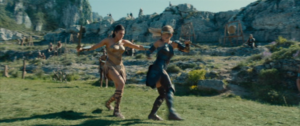
Enter the character Steve Trevor, an American pilot and spy who serves as Diana’s counterpart in the film. However, once Steve crashes on the island and reports the horrific war outside of Themyscira’s borders, Diana becomes convinced to help him and the other mortals as she has the capability to do so. Diana tries to reason with her mother, Hippolyta, to leave the island to defend humans from Ares: “Stopping the god of war is our foreordinance. As Amazons, this is our duty.”[13] However Hippolyta states, “But you are not an Amazon like the rest of us. So, you will do nothing.”[14]While Diana has been raised by the Amazons and identifies with them, Hippolyta affirms that Diana is not due to her birth. Diana defies her mother’s wishes as she “is not an Amazon” to journey off the island to help humanity in the war, embracing the status of a liminal figure in order to help others. It is through this conflict, that Diana forms her identity and realizes that she has a power to help others as she loses this status as an Amazon. Hippolyta informs her that if she leaves, she may never return to the island, however Diana replies “Who will I be if I stay?”[15] She is not a part of the Amazons if she leaves but she will also not be a part of humanity with her heritage. However, it is due to this position that she can leave and discover her power.
London Harbour
Diana’s arrival with Steve in London creates a sense of disorientation for the now “ex”-Amazon. This sense of disorientation is an aspect of the liminal stage that Turner identifies, in which the subject may not feel overly connected to their environment and therefore will often feel lost and isolated.[16] This is certainly the case for Diana when she travels through London with Steve. London is still enjoying the height of its empire as a flourishing city in 1918, and, for Diana, the environment is completely different from that of warm Themyscira.
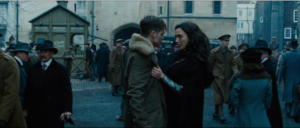
As the pair travel through the harbour, Steve determines that Diana does not “fit in” with the other women of his time, so he deems that Diana needs to change her outfit in order for London’s society to take her seriously. With her loose hair and her cloak covering her stolen Amazonian armour, she is an unusual sight for the generally conservative society of Edwardian London. So, Steve employs his secretary, Etta Candy, to help Diana find more suitable attire. As Diana does not hold a solidified identity in the ‘world of man,’ others can impress different values upon her because her lack of status may be perceived as a threat by society. Mary Douglas states, “that which cannot be clearly classified in terms of traditional criteria of classification, or falls between classificatory boundaries, is almost everywhere regarded as ‘polluting’ and ‘dangerous’.”[17] As the liminal subject may not have a distinct identity, they may disrupt ideals that are represented by the society. As the liminal figure is not a part of a social group, their difference may be perceived as “dangerous” as they have no distinct classification. Turner discusses how “[Henri] Bergson speaks of how in-group preserves its identity against members of out-groups, protects threats to its way of life, and renews the will to maintain the norms on which routine behaviour necessary for its social life depends.”[18] The liminal subject’s identity or values may disrupt the values that are held by the so called ‘in-group,’ which challenges the group’s own ideals. This ‘blank’ and ‘unidentifiable’ liminal subject then has values that are imposed upon her as she does not ‘fit in’ with the social group.
The make-over sequence becomes a parody and a source of comedy in the film, used to criticize the restrictive fashion in the early twentieth century. Diana complains about the mobility and the practicality of the clothing. She looks at a corset, saying, “Is this what passes for armour in your country?”[19] This presumably earns a laugh from the audience but also solidifies the fact that Diana has no conception of what is acceptable in 1918, placing herself outside of the knowledge of the in-group. Etta stammers, “Armour? It’s fashion,”[20] relating to Diana that the role of women in London society is focused on the visual, it is to be looked at. This, of course, can relate to Mulvey’s theory of visual pleasure in cinema, as this moment epitomizes the “to-be-looked-at-ness”[21] . Focusing on a woman’s objectivity than her subjectivity. Diana then tries on a variety of attire with Etta’s guidance. All of the outfits are suitable for the time period but impractical as they inhibit movement. “How can a woman possibly fight in this?”[22] Diana questions while Etta replies, “We use our principles. I mean, that’s how we’re going to get the vote.”[23] With just this brief exchange, the values of
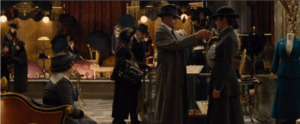
the in-group are communicated; women’s movements are restricted both physically in regard to the fashion and metaphorically in their (in)ability to participate in politics. Etta also implicates with her dialogue that women do not fight physically, unlike what Diana is accustomed to from Themyscira. As Diana refuses the fashion, she also refuses the values that are attached to each outfit, which does not help her integrate into the London culture.
Diana eventually adopts a modest outfit with Etta and Steve’s approval. With this disguise as her new alter ego, ‘Diana Prince’, she is able to confront the men about the war and the actions they must take to make peace. In a heated discussion with the British generals about the war, they ignore both Diana and Steve’s attempts to stop the Germans from developing advanced weapons. Diana appeals compassionately for the vulnerable people in the war, much to the chastising looks of the generals. Steve says, “She’s with me, sir. She’s with us,”[24] advocating for Diana to convince the generals that she is allied with them and part of their group. However, Diana declares, “I am not with you!”[25] as the British generals decide that they will not send support to the front for the vulnerable soldiers (of both sides) and civilians. With this, she distances herself from British society. She argues, “Where I come from generals don’t hide in their offices like cowards, they die on the battlefield with their soldiers.”[26] While at first, Diana appears to have sided with the British, Diana and Steve are not officially working with either side. The two are reinstated as liminal subjects as they choose to leave to enable an armistice that will end the war.
No-Man’s Land
After Diana and Steve abandon Britain for war-torn Europe, they pick up several allies to assist them. Their allies are liminal in their own right as well: Chief Napi, an indigenous Blackfoot demigod; Sameer, an actor turned spy; and Charlie, a Scottish marksman who suffers from PTSD. The motley troop then heads to the front to find the German’s deadly weapons as well as the god of war, Ares, whom Diana believes to be behind the Great War. In Europe, they reach No-Man’s Land. The No-Man’s Land sequence is the central moment in the film as it reveals Diana’s own power while she takes advantage of her liminality. Diana sets out to march through a space which is defined by the fact that no man can cross it. Borders and thresholds such as No-Man’s Land feature prominently in themes of liminality. Karen Kvideland, in Boundaries & Thresholds, observes that “all lines, real or imaginary…mark separation and are intended to keep apart that which they divide.”[27] These borders and lines ensure a kind of order but occasionally can be fatal if crossed. So, Diana physically as well as metaphorically crosses boundaries in this scene. At first, Diana and her group are stuck on British lines. There, Diana sympathizes with a civilian woman who calls Diana to the impossible task to free her fellow civilians in a captured town across No-Man’s Land. Diana must cross it in order to save the civilians. However, Steve insists that “[t]his is No-Man’s Land, Diana. It means no man can cross it…this is not something you can cross. It’s not possible…It’s not what we came here to do” to which Diana assures him, “No. It’s what I’m going to do”[28]. She takes responsibility for the vulnerable and sheds her “Diana Prince” costume, revealing her Amazonian armour.
Though the armour has appeared only in flashes previously in the film, this is the first time that Diana’s “Wonder Woman” armour is revealed in full. As Diana climbs out of the trench, Jenkins shows bits of the armour in individual shots onscreen; each piece of armour references in synecdoche the myth of the original Wonder Woman. With this sequence of Diana’s armour, the camera does not overtly sexualize Diana in this moment of her empowerment by focusing on her body. Instead, Jenkins concentrates on the objects that will define her Wonder Woman: the shield, the gauntlets, the lasso, and her boots. Each of these fragmented shots come together in the reveal of Wonder Woman. This set of armour is the definition of Wonder Woman and who she is in this incarnation of the character, which, along with the rest of the costuming, represents her values. This is the Wonder Woman of our time.
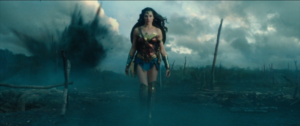
Princess Diana’s original outfit in the comics was carefully designed by Henry George Peter, the original artist, and Marston himself (see figure 5).[29] Marston gave Peter the following instructions, as Jill Lepore illustrates in his biography: “draw a woman who’s as powerful as Superman, as sexy as Miss Fury, as scantily clad as Sheena the jungle queen, and as patriotic as Captain America.”[30] Despite Marston’s intentions to create an upstanding female role model “as strong as Superman,” the hypersexualization of “Wonder Woman’s body assures that female power is reigned in, tacitly directing the primary purpose of the body decorated in national iconography to be an object for male sexual pleasures.”[31]The superhero outfit defines the superhero as it becomes a visual synecdoche for identifying the hero. Oftentimes, a superhero is
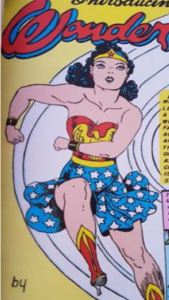
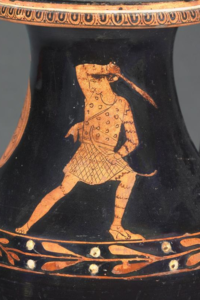
recognized and branded by their outfit. Jenkins and her costume designer Lindy Hemming worked hard to emulate the original look but also to bring the costume to fit more modern perceptions of femininity. The outfit did not have to be overtly hypersexual as in the original comics but rather function practically—or at least enough to convince the audience that it could. In an interview about the costuming and design of the film, Lindy Hemming adds, “[Jenkins] and all of us were trying to tread a line where you didn’t over-sexualize people, but you still were proud of their bodies and proud of how fit they were.”[32] Hemming’s design also mimics the armour of the Amazons depicted in ancient Greek art as seen in figure 6.[33] The concept of the armour is similar; the armoured bodice accompanied by a loose-fitting skirt (not entirely unlike the ancient Greek men), and often carrying a shield. With a few adjustments to the armour, it becomes representative of who Diana is in the film. Wonder Woman’s dainty bracelets become gauntlets and the red boots become inspired gladiator footwear complete with greaves to protect her legs. Accented with gold, the armour in Jenkins’s film is brightly coloured in red and blue and stands out against the dull colours of the battlefield. The golden eagle across her chest, which originally symbolized the American eagle, could now represent the god Zeus, as it is his sacred animal within Greek mythology. While she is fighting with an American in this cinematic version, Diana does not protect a certain country. Her goal is larger to defend humanity rather than just act in the name of just one nation.
After the reveal of her armour, Diana then uses her iconic gauntlets to defend herself from the hail of bullets. Diana’s ancient Greek-inspired outfit looks generally out of place on the Great War battlefield, which creates a sense of disorientation for Diana as well as the audience. While Diana’s liminality in this sequence is largely defined by her actions, her armour also emphasizes that she is in between places, times, and identities. She is the one that can cross No-Man’s Land because she is undefined. After she crosses No-Man’s Land, her musical theme is heard for the first time, signifying to the audience that Wonder Woman fights for the good of humanity, accomplished by altering the preconceived ideas of boundaries.
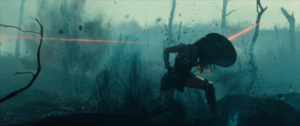
The Air Field
One of the great tragedies of the film comes when Diana realizes that good and bad exist in the enemy as well as her friends. Up until this point, Diana has had a relatively black and white view of war; she has determined, quite naively, that humans are entirely good but has not recognized the capacity of humans’ ability for evil. She realizes that both the potential for good as well as evil exists within humanity, so she recognizes that there is a spectrum rather than just a binary. She learns that humans can be both, that they too can be liminal in their choices. Turner himself postulates that liminality can be “full of potency and potentiality…and that periods of social upheaval ha[ve] the opportunity for the potential to stir that imagination”[34] so that this can lead to “enable individuals to revaluate themselves and their perception of the world”[35]. In the close of the film, Diana states that people have “A choice each must make for themselves. Something no hero can ever defeat.”[36] Liminality, with all its unknowns, is a kind of potential and therein lies its power; it can be anything as it does not have any one definition. It has the potential to be anything as it is not restricted. It is through this liminality that Diana herself holds her power.
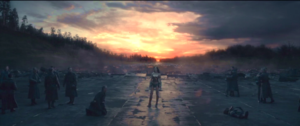
The solidification of Diana’s identity is shown visually at the close of the film. After she has delivered the final strike against Ares, the camera places her in the centre of the frame, near the horizon, emphasized by the cracks on the runway. This horizon line is also intensely saturated with the sunset in the centre while the colour fades towards the edge; colour has once again returned to the dim ‘world of man.’ The men are also gathered around the edges of the shot, showing that while they are important to Diana, she is still at a distance. Diana stands between both sides of opposing men, a position that epitomizes her liminality. It is also important to note that all men are intermingling, Germans and Diana’s group alike, and embracing each other celebrating the end of Ares.
Conclusion
In the introduction to their work Breaking Boundaries, Horvath, Thomassen, and Wydra note that “Reality itself provides no firm ground for neat classification, so in applying classifications to raw realities there will always be an unclassifiable remainder.”[37] It can be through these “raw realities” and “unclassifiable remainders” that meaning can be generated and bridges can be gapped. Jenkins’s work in Wonder Woman, while brilliant, is nowhere near iconoclast. Instead she sets a standard for female representation within superhero film by showing Diana transgress and cross boundaries. With Diana’s costuming along with her actions, she acts as a liminal subject, disrupting the expectations for “insiders” as she travels throughout the world. Her Amazonian heritage, along with “Wonder Woman’s” legacy created by Marston, empowers her to be physically strong as a superhero. However, it is her compassion and love for others that allows her to be somewhat undefinable within her own world and inspires her to defy distinct boundaries as evidence of her liminal journey. Diana’s character recognizes that there will always be this “unclassifiable remainder” and that, in the gaps, there is power in potential.